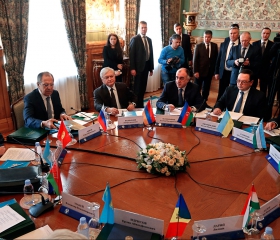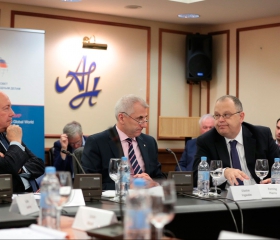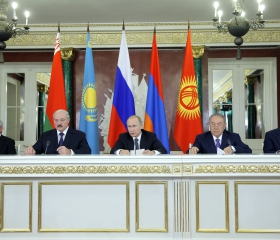The Eurasian Economic Union – today’s framework for the processes of Eurasian integration – has graduated from a period of upbeat progress and achievement status reports to a phase of regrets. Those regrets were expressed in speeches by the presidents of all EEU member states at a meeting of the Supreme Eurasian Economic Council held in Astana on May 31, 2016. While they sound more like wishes for the future so far, to what extent all of the diverging interests of EEU members can be reconciled and realized remains the key question.
The Eurasian Economic Union – today’s framework for the processes of Eurasian integration – has graduated from a period of upbeat progress and achievement status reports to a phase of regrets. Those regrets were expressed in speeches by the presidents of all EEU member states at a meeting of the Supreme Eurasian Economic Council held in Astana on May 31, 2016. While they sound more like wishes for the future so far, to what extent all of the diverging interests of EEU members can be reconciled and realized remains the key question.
Froth on the Daydream
Economic motives have been declared to be the key drivers behind Eurasian integration, particularly in the context of frequent accusations leveled at the EEU for its political undercurrent and restorative nature. Minimizing its political component is important not only for the sake of communications with the outside world, but also in order to find a balance in relations between the Union member countries: It is no secret that the term “Economic” was added to its name as an afterthought.
Yet it has become apparent in recent years that the association’s economic performance is on the wane. The objective limits on mutual trade had been already reached by the time the Union was established. A financial and economic crisis in Russia, which has had an adverse effect on the economies of its neighbors too, has caused a considerable decline in intra-EEU trade (by 25% in 2015 and by a further 30% in the first few months of 2016), something that all summit participants pointed out in their speeches.
Despite the Eurasian Economic Commission’s efforts, trade barriers between the member states remain in place, a fact that Belarusian President Alexander Lukashenko was particularly rueful about. EEU integration has not resolved the issue of trade wars between its members, with trade hurdles representing a particularly acute problem for relations between Kyrgyzstan and Kazakhstan.
Security became a new item on the Eurasian integration agenda in 2016. It was security that Armenia’s President Serge Sargsyan spoke about at the Supreme Eurasian Economic Council meeting, as he made a link between the outlook for economic prosperity and stability across the Union space. After Armenia joined the EEU, it has inherited a smoldering international conflict right in its territory. Different views on Nagorny Karabakh have created yet another reason for disagreements among the Union members.
These differences in approaches came to a head during the April flare-up of the Karabakh conflict. An insufficiently correctly worded official statement by Minsk on the “four-day war” led to the summoning of the Belarusian ambassador to Armenia’s Foreign Ministry for consultations. Kazakhstan’s special position resulted in the cancellation of an EEU intergovernmental council meeting in Yerevan. Astana refused to participate in the scheduled session without explaining the reasons and insisted on moving it to Moscow to dispel any suspicion that the Union might support either party of the conflict.
Even a cursory glance at the general dissatisfaction and the list of mutual grievances reveals the extent of disagreements among the member countries on how to understand the rationale for integration and on a common future. This has only strengthened Russia’s resolve to try and inspire its Union partners with its own vision for its outlook.
Great Expectations
The ultimate goal of Russia’s integration initiatives in Eurasia is to create an efficient and attractive association capable of bringing as many external participants as possible into its sphere of influence while establishing sustainable ties between the leading integration blocks in Europe and Asia. It is those subjects that have moved to the forefront of the EEU’s agenda even as its economic performance flagged.
The expansion of the Union’s external economic ties featured prominently in debates at events leading up to the summit and in Astana too. According to official sources in the Eurasian Economic Commission, more than 40 countries have expressed interest in developing cooperation with the EEU. A year ago the EEU signed its first free trade agreement – with Vietnam, which envisages the elimination of duties on almost 90% of goods over ten years, something that should more than double trade. China is key to the expansion of the circle of partners. The Union has adopted Directives for launching negotiations with China on a non-preferential trade and economic agreement. Yet this is only the tip of the iceberg of EEU’s external economic agenda. The bulk of cooperation with third parties concerns coordination among the Union member countries.
The EEU heads of state have decided to postpone decisions on relations with the European Union and Ukraine in view of the anti-Russian sanctions and counter-sanctions. Effective January 1, 2016, Russia has unilaterally withdrawn from the free-trade area regime with Ukraine and introduced EEU customs duties following Ukraine’s accession to the EU free trade area, and has also imposed a food embargo after Kiev joined the Western sanctions against Russia.
All EEU members are also members of the multilateral CIS free trade area, which sets the regime for their cooperation with Ukraine. Yet keeping trade preferences in place is fraught with an escalation of trade and economic disagreements within the Union, primarily because of deterioration of the “internal offshore” situation, which Belarus has exploited rather successfully after the introduction of mutual sanctions between Russia and the EU. Alexander Lukashenko said in December 2015 that Kazakhstan and Belarus were considering “supporting our ally Russia in a difficult situation”, yet no specific statements were made at the time or at all. As he was leaving the post of Chairman of the Eurasian Economic Commission in December 2015, Viktor Khristenko said that “the EEU member countries will work out mechanisms for responding to the Ukraine–EU free trade area during the first half of 2016 and will establish a single information system to collect data on all goods coming in from the EU by the summer of 2016”.
However, as soon as in February 2016 a meeting in Kiev of the Belarus–Ukraine Advisory Council on Business Cooperation resulted in an official statement on potential utilization of the Ukraine–EU free trade area for the benefit of relations between Ukraine and Belarus. To help the EEU save face in this difficult situation, Moscow was forced to have the Eurasian Economic Commission Integration and Macroeconomics Minister Tatyana Valovaya make it clear that the ability to conduct independent policy was among the Union’s key strengths, therefore “the EEU member countries coordinate their policies in such areas and for as long as it makes economic sense”.
If the summit agenda is any indication, the EEU members decided not to raise the matter of support for Russia’s foreign economic policy anymore, focusing their common external economic policy on signing free trade agreements with third countries instead. But there too there is a risk of uncoordinated steps aimed at the development of bilateral projects with China, in particular by Kazakhstan. That’s why Russia’s diplomatic efforts in this area are aimed at improving coordination within the EEU and achieving as tight consolidation and centralization of cooperation projects between the integration nucleus of the post-Soviet space and China as possible. Case in point: A stated intent to involve the Shanghai Cooperation Organization in the initiative of “connecting” the EEU and China’s Silk Road Economic Belt.
Finally, various sources have announced a new direction for the EEU external economic cooperation: First Kazakhstan’s President Nursultan Nazarbayev and then Russian State Duma Speaker Sergey Naryshkin mentioned a possible EU–EEU forum this autumn to kick off the process of rapprochement between the two blocks. The visit by the President of the European Commission Jean-Claude Juncker to the St. Petersburg International Economic Forum is viewed as a preparatory step towards practical implementation of this idea. This initiative brings the notion of “a common economic space from Lisbon to Vladivostok” to the forefront of the agenda, yet in a new geopolitical reality and on new cooperation terms.
***
The EEU is carrying on with its day-to-day work to tune up the mechanisms of economic integration: This is evidenced by such steps as the approval of the Concept of Establishment of the Common Oil and Oil Product Market or the expedited process of the adoption of the Customs Code. At the same time, much has been made of the strategic development of the Union’s external economic ties, partly to distract from the lack of a meaningful breakthrough in the deepening of integration, but also, perhaps to a greater extent, to give a fresh impetus to the process of searching for common interests of all member countries. The balance between those two directions will determine the vector of the EEU’s development in the short term, while the Union’s long-term potential will hinge on how well those directions complement each other.







